Beginning its journey on the 15th of January 2001, Wikipedia — the internet’s free encyclopedia — has been around for 20 long years, and has become quintessential part of the ever-expanding web culture. Providing billions of users across the world the opportunity to access millions of crowdsourced articles on pretty much any topic one can think of, Wikipedia has become an irreplaceable part of the online culture.
And now, for the first time in 10 years, Wikipedia is all set to get a facelift to make the site all the more approachable to new and existing users.
Olga Vasileva, Lead Product Manager at the Wikimedia Foundation, through a blog post made on the Wikimedia blog, has highlighted all the different parts of the makeover that the website is set to receive in the coming months.
The beloved online knowledge bank is set to receive a reconfigurable logo, improvements in search results, easy language switching feature, a collapsible sidebar, and a revamped table of contents for each article.
On a personal note, the innovative new table of contents is something that appeals to me on a different level. I feel it would facilitate ease of access, allowing users to skip to pertinent sections without continuously scrolling to the top of the page to access the content list, unlike the previous Wikipedia layout.
However, with all the announced features on our hands, Wikimedia has stated that the collapsible sidebar would be the first change to be implemented in the new Wikipedia layout. This feature would allow the user to hide unnecessary texts clogging up the screen and make it easier for the user to focus on the article at hand. This is a welcome change for any individual that spends a long period of time on Wikipedia reading up for an upcoming exam or just plain assignment completion.
The next feature to be added to the new Wikipedia layout will be the maximum line width, a feature that is designed to make it easier for concentrated reading.
Wikimedia has also announced that it will implement these changes gradually over a long period of time, allowing users an opportunity to test the features as they come out. The organization expects the site to have its complete makeover by the end of 2021..
The Tech Portal is published by Blue Box Media Private Limited. Our investors have no influence over our reporting. Read our full Ownership and Funding Disclosure →






